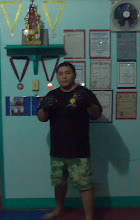Greco-Roman wrestling is a style of amateur wrestling that is practiced throughout the world. Along with freestyle, it is one of the two styles of wrestling contested in the Olympic games.
Colloquially referred to simply as Greco, this style of wrestling forbids attacks below the waist. As a result, throws are encouraged as the Greco-Roman wrestler cannot avoid being thrown by simply hooking or grabbing his opponent's leg. Otherwise, the sport is similar to freestyle.
Arm drags, bearhugs, and headlocks found in freestyle have greater prominence in Greco-Roman. Throws especially known as a suplex are used, in which the offensive wrestler lifts his opponent in a high arch while falling backward on his own neck to a bridge in order to bring his opponent's shoulders down to the mat. Even on the mat, a Greco-Roman wrestler must still find several ways to turn his opponent's shoulders to the mat for a fall without legs, including (but not limited to) techniques known as the bodylock and the gut-wrench.[1]
According to the International Federation of Associated Wrestling Styles (FILA), Greco-Roman wrestling is one of the six main forms of amateur competitive wrestling practiced internationally today. The other five forms are freestyle wrestling, grappling (also called submission wrestling), beach wrestling, pankration athlima and alysh.



























